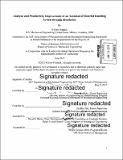| dc.contributor.advisor | Zeynep Ton and Brian Anthony. | en_US |
| dc.contributor.author | Primack, Willow | en_US |
| dc.contributor.other | Leaders for Global Operations Program. | en_US |
| dc.date.accessioned | 2015-09-29T18:58:58Z | |
| dc.date.available | 2015-09-29T18:58:58Z | |
| dc.date.copyright | 2015 | en_US |
| dc.date.issued | 2015 | en_US |
| dc.identifier.uri | http://hdl.handle.net/1721.1/99026 | |
| dc.description | Thesis: M.B.A., Massachusetts Institute of Technology, Sloan School of Management, 2015. In conjunction with the Leaders for Global Operations Program at MIT. | en_US |
| dc.description | Thesis: S.M., Massachusetts Institute of Technology, Department of Mechanical Engineering, 2015. In conjunction with the Leaders for Global Operations Program at MIT. | en_US |
| dc.description | Cataloged from PDF version of thesis. | en_US |
| dc.description | Includes bibliographical references (pages 66-67). | en_US |
| dc.description.abstract | As Amazon.com has grown, the company has invested in warehouse systems similar to those traditionally found in manufacturing. These systems are a complex and interconnected set of manned work processing stations linked together by conveyance. This thesis examines one such system, arranged as a set of parallel single piece workflow lines joined by a central computerized sorter that route work between lines, and examines the effect of sorter algorithms and line capacity on production output. Work studies, interviews, and a practical experiment suggest a deterioration in the feedback provided to the central sorter for work routing. A Monte Carlo simulation model of the system further supports this hypothesis, suggesting that system throughput is 11.7% lower than a system that perfectly routes work to line in a pull fashion. While perfect routing is not practically feasible, the thesis then explores two routing heuristics designed around starvation response and dynamic capacity analysis, which simulation suggest may yield a 6.73% increase in throughput. In doing so, the thesis provides a case study on process improvement using simulation to characterize a complicated mechanical production system that is otherwise analytically intractable. | en_US |
| dc.description.statementofresponsibility | by Willow Primack. | en_US |
| dc.format.extent | 67 pages | en_US |
| dc.language.iso | eng | en_US |
| dc.publisher | Massachusetts Institute of Technology | en_US |
| dc.rights | M.I.T. theses are protected by copyright. They may be viewed from this source for any purpose, but reproduction or distribution in any format is prohibited without written permission. See provided URL for inquiries about permission. | en_US |
| dc.rights.uri | http://dspace.mit.edu/handle/1721.1/7582 | en_US |
| dc.subject | Sloan School of Management. | en_US |
| dc.subject | Mechanical Engineering. | en_US |
| dc.subject | Leaders for Global Operations Program. | en_US |
| dc.title | Analysis and productivity improvement of an automated material handling system through simulation | en_US |
| dc.type | Thesis | en_US |
| dc.description.degree | M.B.A. | en_US |
| dc.description.degree | S.M. | en_US |
| dc.contributor.department | Leaders for Global Operations Program at MIT | en_US |
| dc.contributor.department | Massachusetts Institute of Technology. Department of Mechanical Engineering | |
| dc.contributor.department | Sloan School of Management | |
| dc.identifier.oclc | 921307016 | en_US |
